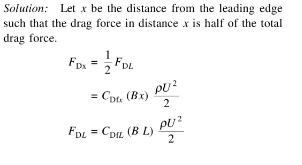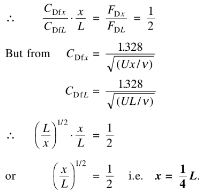Mechanical Engineering Exam > Mechanical Engineering Questions > A Flat smooth rectangular plate is placed edg...
Start Learning for Free
A Flat smooth rectangular plate is placed edgewise in a stream of fluid. At what fraction of the length from the leading edge would the drag force on the front portion be equal to the half of the total drag force? Assume the boundary layer to be laminar.
- a)1/4
- b)1/2
- c)3/4
- d)1
Correct answer is option 'A'. Can you explain this answer?
| FREE This question is part of | Download PDF Attempt this Test |
Verified Answer
A Flat smooth rectangular plate is placed edgewise in a stream of flui...

Most Upvoted Answer
A Flat smooth rectangular plate is placed edgewise in a stream of flui...


Free Test
FREE
| Start Free Test |
Community Answer
A Flat smooth rectangular plate is placed edgewise in a stream of flui...
Understanding the Problem
The problem states that a flat smooth rectangular plate is placed edgewise in a stream of fluid, and we need to determine the fraction of the length from the leading edge at which the drag force on the front portion is equal to half of the total drag force. We are also given that the boundary layer is laminar.
Key Concepts
To solve this problem, we need to understand the concepts of drag force and boundary layer.
- Drag Force: The drag force is the resistance force experienced by an object when it moves through a fluid. It is caused by the interaction between the object and the fluid, resulting in a net force opposing the motion of the object.
- Boundary Layer: The boundary layer is the thin layer of fluid that forms on the surface of an object when it moves through a fluid. It is characterized by a gradual transition of flow velocity from the free stream to zero at the surface of the object. The boundary layer can be laminar or turbulent, depending on the fluid flow conditions.
Solution
To determine the fraction of the length from the leading edge at which the drag force on the front portion is equal to half of the total drag force, we need to consider the distribution of drag force along the length of the plate.
- The drag force experienced by a flat plate in a fluid flow is given by the equation:
Fd = 0.5 * ρ * V^2 * Cd * A
Where Fd is the drag force, ρ is the density of the fluid, V is the velocity of the fluid, Cd is the drag coefficient, and A is the reference area of the plate.
- The drag coefficient depends on the shape of the object and the flow conditions. For a flat plate in laminar flow, the drag coefficient is given by:
Cd = 1.328 / Re^0.5
Where Re is the Reynolds number, which is a dimensionless parameter that characterizes the flow regime. For laminar flow over a flat plate, Re is given by:
Re = (ρ * V * L) / μ
Where L is the length of the plate and μ is the dynamic viscosity of the fluid.
- We can assume that the drag force distribution along the length of the plate is linear. Therefore, the drag force on the front portion of the plate is equal to half of the total drag force when the distance from the leading edge is equal to half of the length of the plate.
Fraction = 0.5 * L / L = 0.5
Therefore, the correct answer is option 'B' 1/2.
Attention Mechanical Engineering Students!
To make sure you are not studying endlessly, EduRev has designed Mechanical Engineering study material, with Structured Courses, Videos, & Test Series. Plus get personalized analysis, doubt solving and improvement plans to achieve a great score in Mechanical Engineering.

|
Explore Courses for Mechanical Engineering exam
|

|
Similar Mechanical Engineering Doubts
A Flat smooth rectangular plate is placed edgewise in a stream of fluid. At what fraction of the length from the leading edge would the drag force on the front portion be equal to the half of the total drag force? Assume the boundary layer to be laminar.a)1/4b)1/2c)3/4d)1Correct answer is option 'A'. Can you explain this answer?
Question Description
A Flat smooth rectangular plate is placed edgewise in a stream of fluid. At what fraction of the length from the leading edge would the drag force on the front portion be equal to the half of the total drag force? Assume the boundary layer to be laminar.a)1/4b)1/2c)3/4d)1Correct answer is option 'A'. Can you explain this answer? for Mechanical Engineering 2024 is part of Mechanical Engineering preparation. The Question and answers have been prepared according to the Mechanical Engineering exam syllabus. Information about A Flat smooth rectangular plate is placed edgewise in a stream of fluid. At what fraction of the length from the leading edge would the drag force on the front portion be equal to the half of the total drag force? Assume the boundary layer to be laminar.a)1/4b)1/2c)3/4d)1Correct answer is option 'A'. Can you explain this answer? covers all topics & solutions for Mechanical Engineering 2024 Exam. Find important definitions, questions, meanings, examples, exercises and tests below for A Flat smooth rectangular plate is placed edgewise in a stream of fluid. At what fraction of the length from the leading edge would the drag force on the front portion be equal to the half of the total drag force? Assume the boundary layer to be laminar.a)1/4b)1/2c)3/4d)1Correct answer is option 'A'. Can you explain this answer?.
A Flat smooth rectangular plate is placed edgewise in a stream of fluid. At what fraction of the length from the leading edge would the drag force on the front portion be equal to the half of the total drag force? Assume the boundary layer to be laminar.a)1/4b)1/2c)3/4d)1Correct answer is option 'A'. Can you explain this answer? for Mechanical Engineering 2024 is part of Mechanical Engineering preparation. The Question and answers have been prepared according to the Mechanical Engineering exam syllabus. Information about A Flat smooth rectangular plate is placed edgewise in a stream of fluid. At what fraction of the length from the leading edge would the drag force on the front portion be equal to the half of the total drag force? Assume the boundary layer to be laminar.a)1/4b)1/2c)3/4d)1Correct answer is option 'A'. Can you explain this answer? covers all topics & solutions for Mechanical Engineering 2024 Exam. Find important definitions, questions, meanings, examples, exercises and tests below for A Flat smooth rectangular plate is placed edgewise in a stream of fluid. At what fraction of the length from the leading edge would the drag force on the front portion be equal to the half of the total drag force? Assume the boundary layer to be laminar.a)1/4b)1/2c)3/4d)1Correct answer is option 'A'. Can you explain this answer?.
Solutions for A Flat smooth rectangular plate is placed edgewise in a stream of fluid. At what fraction of the length from the leading edge would the drag force on the front portion be equal to the half of the total drag force? Assume the boundary layer to be laminar.a)1/4b)1/2c)3/4d)1Correct answer is option 'A'. Can you explain this answer? in English & in Hindi are available as part of our courses for Mechanical Engineering.
Download more important topics, notes, lectures and mock test series for Mechanical Engineering Exam by signing up for free.
Here you can find the meaning of A Flat smooth rectangular plate is placed edgewise in a stream of fluid. At what fraction of the length from the leading edge would the drag force on the front portion be equal to the half of the total drag force? Assume the boundary layer to be laminar.a)1/4b)1/2c)3/4d)1Correct answer is option 'A'. Can you explain this answer? defined & explained in the simplest way possible. Besides giving the explanation of
A Flat smooth rectangular plate is placed edgewise in a stream of fluid. At what fraction of the length from the leading edge would the drag force on the front portion be equal to the half of the total drag force? Assume the boundary layer to be laminar.a)1/4b)1/2c)3/4d)1Correct answer is option 'A'. Can you explain this answer?, a detailed solution for A Flat smooth rectangular plate is placed edgewise in a stream of fluid. At what fraction of the length from the leading edge would the drag force on the front portion be equal to the half of the total drag force? Assume the boundary layer to be laminar.a)1/4b)1/2c)3/4d)1Correct answer is option 'A'. Can you explain this answer? has been provided alongside types of A Flat smooth rectangular plate is placed edgewise in a stream of fluid. At what fraction of the length from the leading edge would the drag force on the front portion be equal to the half of the total drag force? Assume the boundary layer to be laminar.a)1/4b)1/2c)3/4d)1Correct answer is option 'A'. Can you explain this answer? theory, EduRev gives you an
ample number of questions to practice A Flat smooth rectangular plate is placed edgewise in a stream of fluid. At what fraction of the length from the leading edge would the drag force on the front portion be equal to the half of the total drag force? Assume the boundary layer to be laminar.a)1/4b)1/2c)3/4d)1Correct answer is option 'A'. Can you explain this answer? tests, examples and also practice Mechanical Engineering tests.

|
Explore Courses for Mechanical Engineering exam
|

|
Suggested Free Tests
Signup for Free!
Signup to see your scores go up within 7 days! Learn & Practice with 1000+ FREE Notes, Videos & Tests.
























